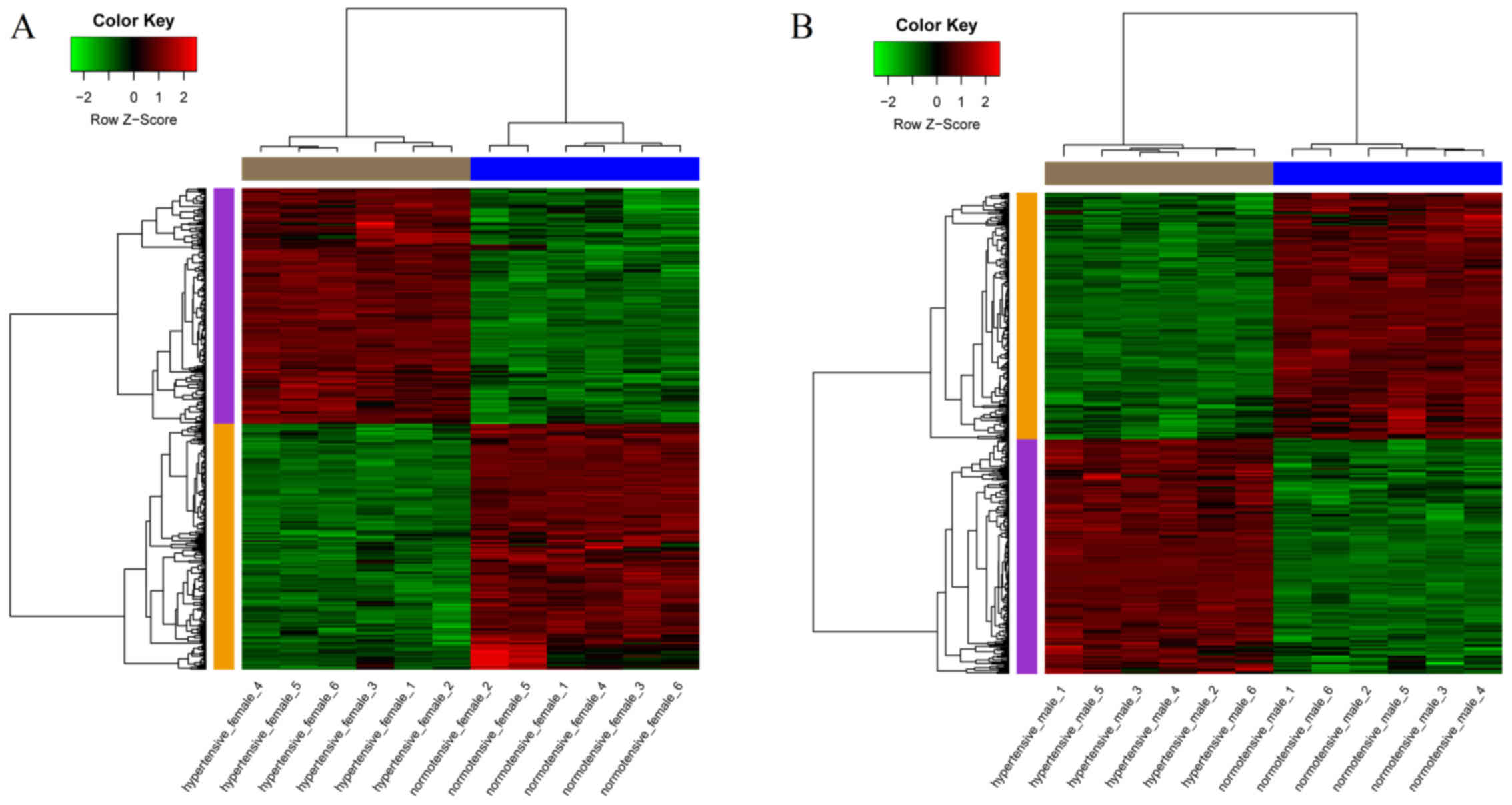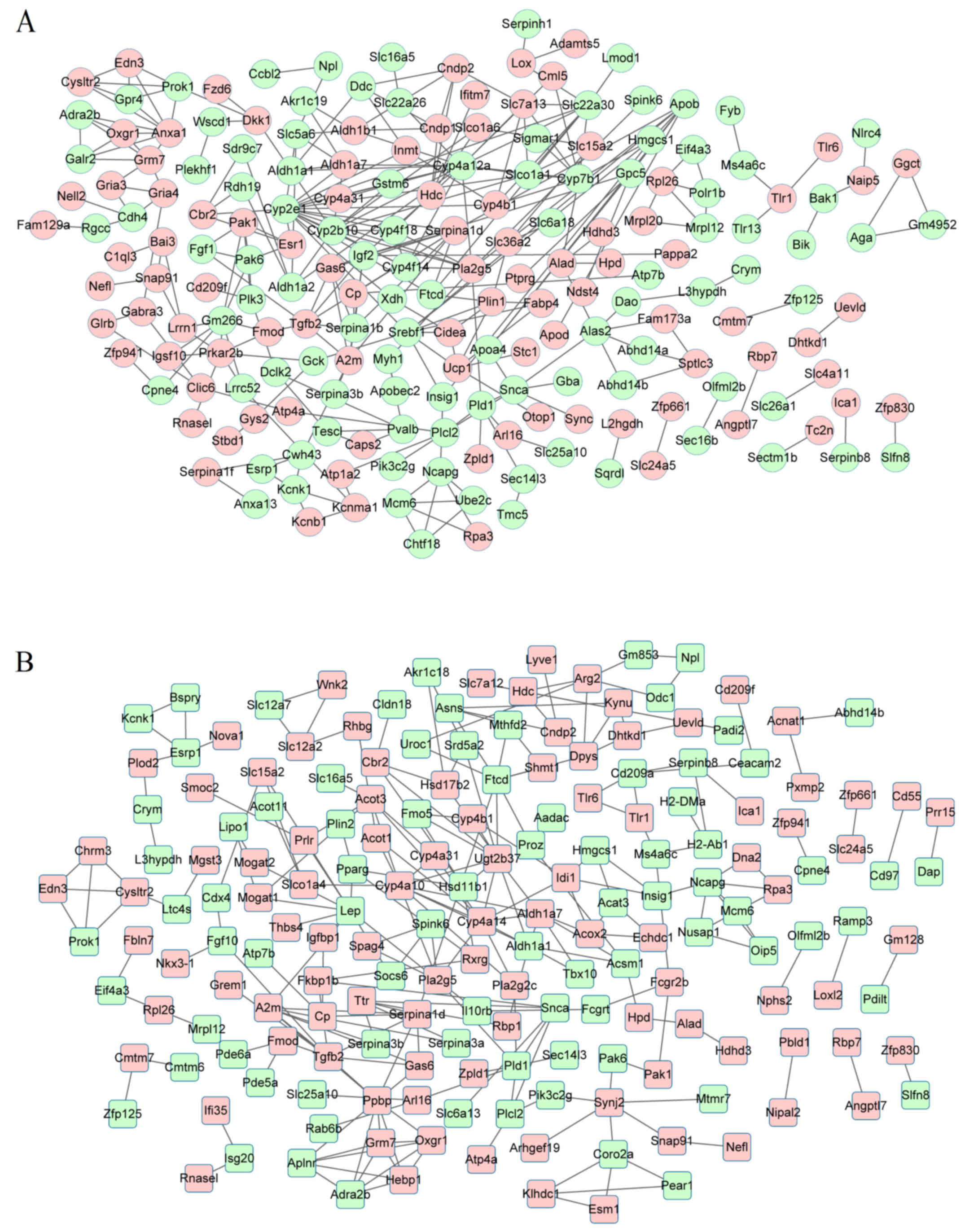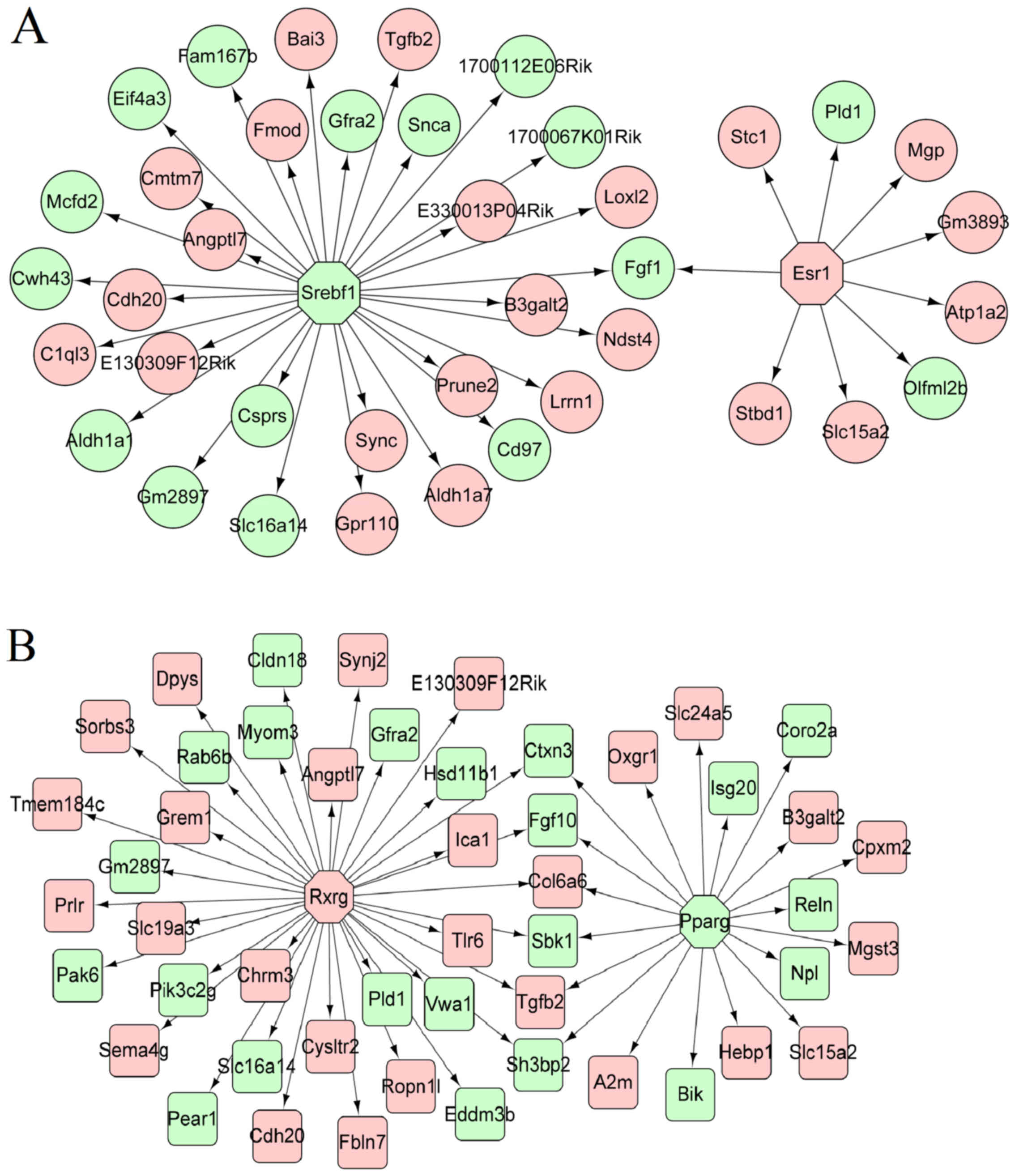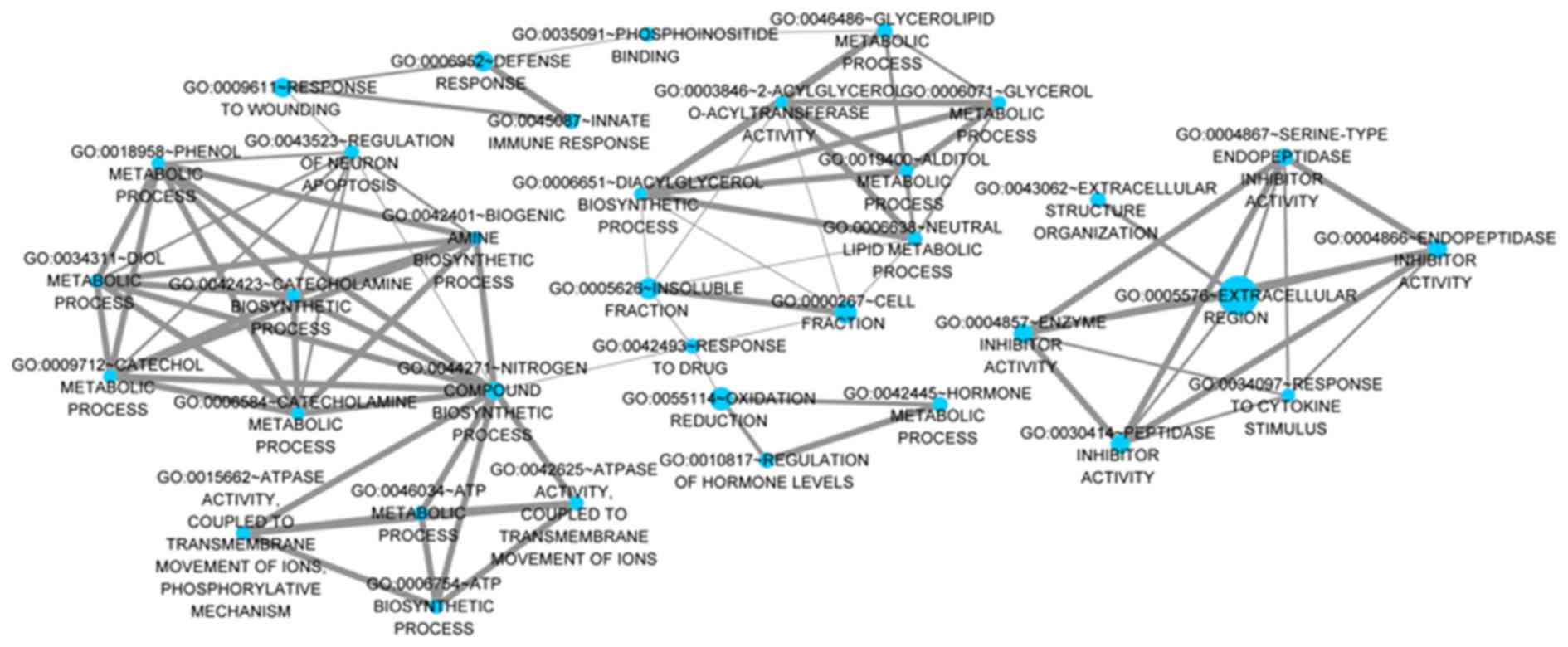|
1
|
Lupton SJ, Chiu CL and Lind JM: A
hypertension gene: are we there yet? Twin Res Hum Genet.
14:295–304. 2011. View Article : Google Scholar : PubMed/NCBI
|
|
2
|
Chiu CL, Jackson KL, Hearn L, Steiner N,
Head GA and Lind JM: Identification of genes with altered
expression in male and female Schlager hypertensive mice. BMC Med
Genet. 15:1012014. View Article : Google Scholar : PubMed/NCBI
|
|
3
|
Williams SS: Advances in genetic
hypertension. Curr Opin Pediatr. 19:192–198. 2007. View Article : Google Scholar : PubMed/NCBI
|
|
4
|
Chobanian AV, Bakris GL, Black HR, Cushman
WC, Green LA, Izzo JL Jr, Jones DW, Materson BJ, Oparil S, Wright
JT Jr, et al Joint National Committee on Prevention, Detection,
Evaluation, and Treatment of High Blood Pressure. National Heart,
Lung, and Blood Institute; National High Blood Pressure Education
Program Coordinating Committee: Seventh report of the joint
national committee on prevention, detection, evaluation, and
treatment of high blood pressure. Hypertension. 42:1206–1252. 2003.
View Article : Google Scholar : PubMed/NCBI
|
|
5
|
Mendis S, Puska P and Norrving B: Global
atlas on cardiovascular disease prevention and control. World
Health Organization; Geneva: 2011
|
|
6
|
Northcott CA, Glenn JP, Shade RE, Kammerer
CM, Hinojosa-Laborde C, Fink GD, Haywood JR and Cox LA: A custom
rat and baboon hypertension gene array to compare experimental
models. Exp Biol Med (Maywood). 237:99–110. 2012. View Article : Google Scholar
|
|
7
|
Ehret GB, Munroe PB, Rice KM, Bochud M,
Johnson AD, Chasman DI, Smith AV, Tobin MD, Verwoert GC, Hwang SJ,
et al International Consortium for Blood Pressure Genome-Wide
Association Studies; CARDIoGRAM consortium; CKDGen Consortium;
KidneyGen Consortium; EchoGen consortium: CHARGE-HF consortium:
Genetic variants in novel pathways influence blood pressure and
cardiovascular disease risk. Nature. 478:103–109. 2011. View Article : Google Scholar : PubMed/NCBI
|
|
8
|
Lifton RP, Gharavi AG and Geller DS:
Molecular mechanisms of human hypertension. Cell. 104:545–556.
2001. View Article : Google Scholar : PubMed/NCBI
|
|
9
|
Machado RD, Eickelberg O, Elliott CG,
Geraci MW, Hanaoka M, Loyd JE, Newman JH, Phillips JA III, Soubrier
F, Trembath RC, et al: Genetics and genomics of pulmonary arterial
hypertension. J Am Coll Cardiol. 54(Suppl 1): S32–S42. 2009.
View Article : Google Scholar : PubMed/NCBI
|
|
10
|
Gooch JL and Sharma AC: Targeting the
immune system to treat hypertension: where are we? Curr Opin
Nephrol Hypertens. 23:473–479. 2014. View Article : Google Scholar : PubMed/NCBI
|
|
11
|
Austin ED, Ma L, LeDuc C, Berman
Rosenzweig E, Borczuk A, Phillips JA III, Palomero T, Sumazin P,
Kim HR, Talati MH, et al: Whole exome sequencing to identify a
novel gene (caveolin-1) associated with human pulmonary arterial
hypertension. Circ Cardiovasc Genet. 5:336–343. 2012. View Article : Google Scholar : PubMed/NCBI
|
|
12
|
Puig O, Wang I-M, Cheng P, Zhou P, Roy S,
Cully D, Peters M, Benita Y, Thompson J and Cai TQ: Transcriptome
profiling and network analysis of genetically hypertensive mice
identifies potential pharmacological targets of hypertension.
Physiol Genomics. 42A:24–32. 2010. View Article : Google Scholar : PubMed/NCBI
|
|
13
|
Carvalho BS and Irizarry RA: A framework
for oligonucleotide microarray preprocessing. Bioinformatics.
26:2363–2367. 2010. View Article : Google Scholar : PubMed/NCBI
|
|
14
|
Irizarry RA, Hobbs B, Collin F,
Beazer-Barclay YD, Antonellis KJ, Scherf U and Speed TP:
Exploration, normalization, and summaries of high density
oligonucleotide array probe level data. Biostatistics. 4:249–264.
2003. View Article : Google Scholar : PubMed/NCBI
|
|
15
|
Smyth GK: Limma: linear models for
microarray data. Bioinformatics and Computational Biology Solutions
using R and Bioconductor. Gentleman R, Carey V, Huber W, Irizarry R
and Dudoit S: Springer; New York: pp. 397–420. 2005, View Article : Google Scholar
|
|
16
|
Ferreira JA: The Benjamini-Hochberg method
in the case of discrete test statistics. Int J Biostat. 3:112007.
View Article : Google Scholar
|
|
17
|
Harris MA, Clark J, Ireland A, Lomax J,
Ashburner M, Foulger R, Eilbeck K, Lewis S, Marshall B, Mungall C,
et al: Gene Ontology Consortium: The Gene Ontology (GO) database
and informatics resource. Nucleic Acids Res. 32:D258–D261. 2004.
View Article : Google Scholar
|
|
18
|
Kanehisa M and Goto S: KEGG: Kyoto
encyclopedia of genes and genomes. Nucleic Acids Res. 28:27–30.
2000. View Article : Google Scholar
|
|
19
|
Huang W, Sherman BT and Lempicki RA:
Systematic and integrative analysis of large gene lists using DAVID
bioinformatics resources. Nat Protoc. 4:44–57. 2009. View Article : Google Scholar
|
|
20
|
Szklarczyk D, Franceschini A, Wyder S,
Forslund K, Heller D, Huerta-Cepas J, Simonovic M, Roth A, Santos
A, Tsafou KP, et al: STRING v10: protein-protein interaction
networks, integrated over the tree of life. Nucleic Acids Res.
43:D447–D452. 2015. View Article : Google Scholar
|
|
21
|
Shannon P, Markiel A, Ozier O, Baliga NS,
Wang JT, Ramage D, Amin N, Schwikowski B and Ideker T: Cytoscape: a
software environment for integrated models of biomolecular
interaction networks. Genome Res. 13:2498–2504. 2003. View Article : Google Scholar : PubMed/NCBI
|
|
22
|
Tang Y, Li M, Wang J, Pan Y and Wu FX:
CytoNCA: a cytoscape plugin for centrality analysis and evaluation
of protein interaction networks. Biosystems. 127:67–72. 2015.
View Article : Google Scholar
|
|
23
|
Janky R, Verfaillie A, Imrichová H, Van de
Sande B, Standaert L, Christiaens V, Hulselmans G, Herten K, Naval
Sanchez M, Potier D, et al: iRegulon: from a gene list to a gene
regulatory network using large motif and track collections. PLoS
Comput Biol. 10:e10037312014. View Article : Google Scholar : PubMed/NCBI
|
|
24
|
Merico D, Isserlin R, Stueker O, Emili A
and Bader GD: Enrichment map: a network-based method for gene-set
enrichment visualization and interpretation. PLoS One.
5:e139842010. View Article : Google Scholar : PubMed/NCBI
|
|
25
|
Touyz RM: Reactive oxygen species in
vascular biology: role in arterial hypertension. Expert Rev
Cardiovasc Ther. 1:91–106. 2003. View Article : Google Scholar
|
|
26
|
Chabrashvili T, Tojo A, Onozato ML,
Kitiyakara C, Quinn MT, Fujita T, Welch WJ and Wilcox CS:
Expression and cellular localization of classic NADPH oxidase
subunits in the spontaneously hypertensive rat kidney.
Hypertension. 39:269–274. 2002. View Article : Google Scholar : PubMed/NCBI
|
|
27
|
Redón J, Oliva MR, Tormos C, Giner V,
Chaves J, Iradi A and Sáez GT: Antioxidant activities and oxidative
stress byproducts in human hypertension. Hypertension.
41:1096–1101. 2003. View Article : Google Scholar : PubMed/NCBI
|
|
28
|
Nelson DR and Nebert DW: Cytochrome P450
(CYP) gene superfamily. eLS. 2011. View Article : Google Scholar
|
|
29
|
Marji JS, Wang M-H and Laniado-Schwartzman
M: Cytochrome P-450 4A isoform expression and 20-HETE synthesis in
renal preglomerular arteries. Am J Physiol Renal Physiol.
283:F60–F67. 2002. View Article : Google Scholar : PubMed/NCBI
|
|
30
|
Singh H, Cheng J, Deng H, Kemp R, Ishizuka
T, Nasjletti A and Schwartzman ML: Vascular cytochrome P450 4A
expression and 20-hydroxyeicosatetraenoic acid synthesis contribute
to endothelial dysfunction in androgen-induced hypertension.
Hypertension. 50:123–129. 2007. View Article : Google Scholar : PubMed/NCBI
|
|
31
|
Sacerdoti D, Escalante B, Abraham NG,
Mcgiff JC, Levere RD and Schwartzman ML: Treatment with tin
prevents the development of hypertension in spontaneously
hypertensive rats. Science. 243:388–390. 1989. View Article : Google Scholar : PubMed/NCBI
|
|
32
|
Kobayashi N, Ohno T, Yoshida K, Fukushima
H, Mamada Y, Nomura M, Hirata H, Machida Y, Shinoda M, Suzuki N, et
al: Cardioprotective mechanism of telmisartan via PPAR-γ-eNOS
pathway in dahl salt-sensitive hypertensive rats. Am J Hypertens.
21:576–581. 2008. View Article : Google Scholar : PubMed/NCBI
|
|
33
|
Mendelsohn ME and Karas RH: The protective
effects of estrogen on the cardiovascular system. N Engl J Med.
340:1801–1811. 1999. View Article : Google Scholar : PubMed/NCBI
|
|
34
|
Barrett-Connor E: Sex differences in
coronary heart disease. Why are women so superior? The 1995 Ancel
Keys Lecture. Circulation. 95:252–264. 1997. View Article : Google Scholar : PubMed/NCBI
|
|
35
|
Mendelsohn ME: Protective effects of
estrogen on the cardiovascular system. Am J Cardiol. 89:12E–17E.
2002. View Article : Google Scholar : PubMed/NCBI
|
|
36
|
Kersten S, Desvergne B and Wahli W: Roles
of PPARs in health and disease. Nature. 405:421–424. 2000.
View Article : Google Scholar : PubMed/NCBI
|
|
37
|
Yilmaz-Aydogan H, Kurnaz O, Kurt O,
Akadam-Teker B, Kucukhuseyin O, Tekeli A and Isbir T: Effects of
the PPARG P12A and C161T gene variants on serum lipids in coronary
heart disease patients with and without type 2 diabetes. Mol Cell
Biochem. 358:355–363. 2011. View Article : Google Scholar : PubMed/NCBI
|
|
38
|
Matsuda Y, Hoshikawa Y, Ameshima S, Suzuki
S, Okada Y, Tabata T, Sugawara T, Matsumura Y and Kondo T: Effects
of peroxisome proliferator-activated receptor gamma ligands on
monocrotaline-induced pulmonary hypertension in rats. Nihon Kokyuki
Gakkai Zasshi. 43:283–288. 2005.In Japanese. PubMed/NCBI
|
|
39
|
Nohara A, Kawashiri M-A, Claudel T, Mizuno
M, Tsuchida M, Takata M, Katsuda S, Miwa K, Inazu A, Kuipers F, et
al: High frequency of a retinoid X receptor γ gene variant in
familial combined hyperlipidemia that associates with atherogenic
dyslipidemia. Arterioscler Thromb Vasc Biol. 27:923–928. 2007.
View Article : Google Scholar : PubMed/NCBI
|
|
40
|
Sucov HM, Dyson E, Gumeringer CL, Price J,
Chien KR and Evans RM: RXR alpha mutant mice establish a genetic
basis for vitamin A signaling in heart morphogenesis. Genes Dev.
8:1007–1018. 1994. View Article : Google Scholar : PubMed/NCBI
|
|
41
|
Osorio JC, Stanley WC, Linke A, Castellari
M, Diep QN, Panchal AR, Hintze TH, Lopaschuk GD and Recchia FA:
Impaired myocardial fatty acid oxidation and reduced protein
expression of retinoid X receptor-α in pacing-induced heart
failure. Circulation. 106:606–612. 2002. View Article : Google Scholar : PubMed/NCBI
|
|
42
|
Rodríguez C, Martínez-González J, Raposo
B, Alcudia JF, Guadall A and Badimon L: Regulation of lysyl oxidase
in vascular cells: lysyl oxidase as a new player in cardiovascular
diseases. Cardiovasc Res. 79:7–13. 2008. View Article : Google Scholar : PubMed/NCBI
|
|
43
|
Mäki JM, Räsänen J, Tikkanen H, Sormunen
R, Mäkikallio K, Kivirikko KI and Soininen R: Inactivation of the
lysyl oxidase gene Lox leads to aortic aneurysms, cardiovascular
dysfunction, and perinatal death in mice. Circulation.
106:2503–2509. 2002. View Article : Google Scholar : PubMed/NCBI
|
|
44
|
Lucero HA and Kagan HM: Lysyl oxidase: an
oxidative enzyme and effector of cell function. Cell Mol Life Sci.
63:2304–2316. 2006. View Article : Google Scholar : PubMed/NCBI
|
|
45
|
Sibon I, Sommer P, Lamaziere JM and Bonnet
J: Lysyl oxidase deficiency: a new cause of human arterial
dissection. Heart. 91:e33. 2005. View Article : Google Scholar : PubMed/NCBI
|
|
46
|
Nakashima Y and Sueishi K: Alteration of
elastic architecture in the lathyritic rat aorta implies the
pathogenesis of aortic dissecting aneurysm. Am J Pathol.
140:959–969. 1992.PubMed/NCBI
|













